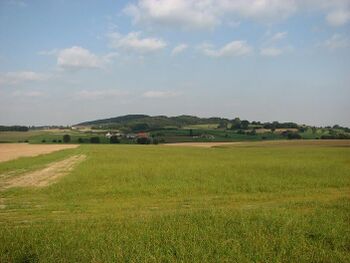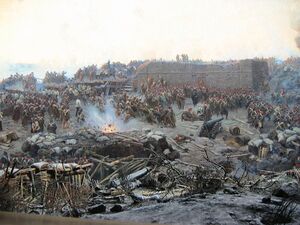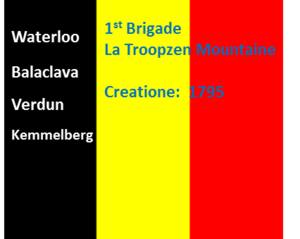Belgian Mountain Troops
The Belgian Mountain Troops are a brigade of the Belgian National Forces organised to overcome geographical limitations in warfare. They are among the world's finest in their field. They train many other countries' mountain troops, such as the Netherlands Mountain Troops and the Kansas Mountain Troops. They are the most elite force in the Belgian army and have been awarded four battle honours on their regimental flag, the most of any unit in the Belgian military. There is currently one active battalion of Belgian Mountain Troops; recently they have been working alongside the SAS, the SBS and the Royal Marine Commandos in dangerous operations off the coast of Somalia.
Their Formation
The Belgian Mountain Brigade was originally formed under General Poirot as a special unit in the Batavian forces in 1795. It was formed when the General ordered his men to march up Mt. Kemmelberg in Belgium and his men barely made it half-way. The General found this unacceptable and ordered a new brigade to be formed and given specific instruction in climbing up hills or even mountains. They trained daily on the slopes of Mount Kemmelberg. At 156m high it took each soldier approximately 23 minutes to run up the mountain and back down again in full kit, the current known record in running up and back down a mountain.
The Brigade was posted to the Batavian-Westphalian border where it awaited assignment in Napoleon's army. This assignment never came, as Napoleon, upon hearing of the Belgian Mountain Brigade, thought it was just a joke, possibly because no one had ever attempted to climb a mountain in battle (apart from Hannibal but then that is an ancient mystery). The Belgians did not believe that that really was Napoleon's reaction as they simply presumed that the French had no sense of humour.
The First Battle Honour: Waterloo
Their first battle honour was granted by King Hercule of Belgium shortly after the Battle of Waterloo. The Belgian Mountain Brigade fought on the allies' side under the 4th Dutch-Belgian Infantry Division. They were stationed in reserve for most of the day until their call to battle was received and they slowly advanced onto the slopes of the crest that the Duke of Wellington was defending. However near the top of the crest they ran into a slight problem when the front rank collapsed in exhaustion. They could not go on any further. Their training climbing a 156m Mt. Kemmelberg was useless when confronted with a 200m high ridge that held Wellington's positions. Despite their failure to reach the battle, the allies still won and the French were beaten. They were awarded their first battle honours.
The Second Battle Honour: Balaclava
In the 1850s Britain and Russia had a big dispute that turned into the Crimean War in which Britain and France (and Austria nearly) invaded Russia. Unbeknown to most historians, one of the first troop units to land was the Dutch Mountain Brigade. They were chosen to represent Belgium as the Crimean Campaign had lots of mountains and they seemed to be experts with these mysterious mountain things. After landing they were instructed to be the first ones to move inland. They approached the whole Russian army as just one brigade and managed to strategically manoeuvre through the Russian army as the Russians mistook the poorly equipped Belgians as Russian peasants. On realising that they had just marched straight through the Russian army, General Poirot, still in command of the force, ordered them to turn around and attack the Russian rear lines of communication. However the Russian major in charge of the Russian supply lines once again mistook the Belgians as Russian peasants and set them to work caring for the wounded. In a vain effort to help the Belgian-British-French-Austrian war effort the Belgian Mountain Troops were viscously forced to slaughter the Russian wounded. The Russians took no notice, however as they had plenty millions of men to spare. After the campaign ended, there was a mix-up in logistics and the Belgian Mountain Troops were left behind in the midst of Russia. The unit was officially reported missing and disbanded by the Belgian government before a search party was even sent out.
Re-establishment of the Belgian Mountain Brigade
During WW1 the Belgian government was forced to conscript every man it could to help the war effort against the Germans. Suddenly they remembered about the lost Belgian Mountain Brigade and sent an envoy into Russia to search for them. When the envoy reached the site of Balaclava he found a huge settlement of people speaking a cross between Russian and French Flemish. These were the great-grandsons of the Belgian Mountain Troops and they all came back to Belgium to reform the old brigade.
Third Battle Honour: Verdun
The Belgian Mountain Brigade was posted to France where there might be more mountains than Belgium. They fought furiously on the rear lines of the trenches and mainly worked in operating communication lines and digging trenches. Their hour of glory came at Verdun when they famously opened the gates of a nearby fort so that the Germans could come rushing in. They thought the Germans were the French and didn't actually realise what they had done until a DNA test was taken that proved that the new occupants of the fort were in fact aryan and not frog. The Belgians said it was an easy mistake to make, after all what is it William Shakespeare once said?
“Two households, both alike in dignity, where we host our play, in fair Verdun.”
Despite these misfortunes and a lot of grovelling later, King Hercule XVI presented them with battle honours for Verdun.
Fourth Battle Honours: Kemmelberg
“At Kemmelberg they stood. Those tired Belgians, scarred from battle. They'd seen the worst before. So they stood and they fought.”
“If the Belgian Empire is to last for a thousand more years: this shall be their finest hour.”
The Battle of Mt. Kemmelberg, or as it is more widely known to the British, "The little rearguard action some Belgians lost while we escaped in Dunkirk", was considered the second greatest battle Belgium has ever fought after Waterloo. It was fought between the Belgian Mountain Brigade positioned at the top of Mt.Kemmelberg and the Austrian Marine Detachment positioned at the bottom of the hill. The Austrians charged up the hill and after the Belgians had expelled all their rounds the Belgian Mountain Division were ordered to climb to the top of the radio mast on top of the mountain. This annoyed the Austrians as the Austrians didn't have any mountain divisions so couldn't climb the radio mast. The Belgians waited for two hours until the Austrians ran away. Then the Belgians marched back to Brussels where they realised they had lost the war, surrendering to the Axis powers. After the country was liberated in 1944, the president of Belgium, Hercule, awarded them battle honours for their innovative action on the mountain.
| ||||||||||||||
| Featured version: 2 May 2013 | |
| This article has been featured on the main page. — You can vote for or nominate your favourite articles at Uncyclopedia:VFH. | |



